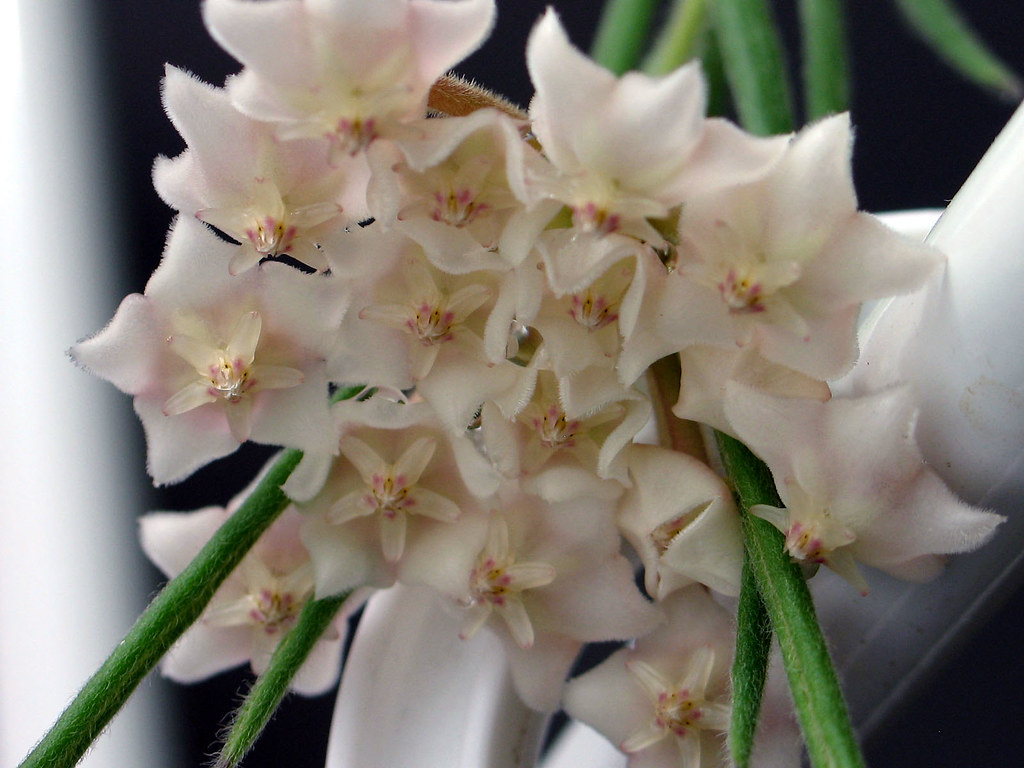Hoya Linearis is a striking species of the Hoya genus, often sought after by plant enthusiasts for its unique and eye-catching appearance. Unlike other Hoyas with broad, waxy leaves, Hoya Linearis is characterized by its narrow, linear leaves hanging down from the vine like a curtain. The delicate, pendulous nature of the plant lends itself beautifully to hanging baskets, creating a soft, cascading effect.
Native to the Himalayas, Hoya Linearis is adapted to cooler and more humid environments. The plant is known to bloom fragrant, star-shaped white flowers with a pinkish center. The flowers grow in clusters, further enhancing the plant’s aesthetic appeal. However, getting the plant to flower indoors can be a challenging task and requires specific care.
Although it is a beautiful addition to any indoor space, Hoya Linearis can be somewhat demanding in terms of care, particularly when it comes to lighting and humidity. Its delicate leaves are prone to drying, and it requires a careful balance of conditions to thrive. The following comprehensive guide provides detailed insights into the care and maintenance of Hoya Linearis.
| Attribute | Details |
|---|---|
| Common Names | Hoya Linearis, Wax Plant |
| Botanical Name | Hoya Linearis |
| Family | Apocynaceae |
| Plant Type | Succulent, Vine |
| Mature Size | Up to 4 feet |
| Sun Exposure | Bright, indirect light |
| Soil Type | Well-draining soil |
| Hardiness Zones | 10-11 |
| Native Area | Himalayas |
Hoya Linearis Care
Hoya Linearis requires meticulous attention to its specific needs, especially in terms of lighting and humidity. The perfect spot for this plant would provide bright, indirect sunlight without any direct rays that could scorch the leaves. Maintaining a consistent temperature and providing ample humidity will help this unique plant to thrive.
Watering must be carefully balanced, as Hoya Linearis does not like to be overly wet. Using well-draining soil and allowing the top layer to dry between watering sessions will create the ideal moisture level for this plant. Over-watering can quickly lead to root rot, which can be fatal for this delicate species.
Light Requirement for Hoya Linearis
Bright, indirect sunlight is essential for Hoya Linearis. Direct sunlight can damage the leaves, causing them to dry out and become discolored. A location near an east or north-facing window, possibly with a sheer curtain to diffuse the light, can be an excellent spot for this plant.
Soil Requirements for Hoya Linearis
A well-draining soil mixture that includes organic matter such as peat moss, perlite, or sand is suitable for Hoya Linearis. The soil must allow excess water to escape easily to prevent root rot and other moisture-related problems.
Water Requirements for Hoya Linearis
Watering should be done carefully, allowing the top layer of soil to dry between watering sessions. Over-watering is a common issue and can quickly lead to root rot. Conversely, under-watering may result in dry, brittle leaves.
Temperature and Humidity
Hoya Linearis thrives in temperatures between 50-75°F (10-24°C). Humidity levels should be kept high, around 60-80%. A humidifier or placing the plant in a bathroom with frequent showers can help maintain the needed humidity levels.
Fertilizer
Feeding Hoya Linearis with a balanced, water-soluble fertilizer every 4-6 weeks during the growing season supports healthy growth. Over-fertilizing should be avoided.
Pruning Hoya Linearis
Pruning can be performed to maintain the desired shape or to remove dead or damaged growth. However, excessive pruning should be avoided, as it may hinder the plant’s natural growth pattern.
Propagating Hoya Linearis
Propagation can be achieved through stem cuttings. A healthy stem with at least one node can be placed in water or a well-draining soil mix to root.
How To Grow Hoya Linearis From Seed
Growing Hoya Linearis from seed is rarely practiced and can be quite challenging. If attempted, seeds should be sown in a well-draining medium and kept in a warm and humid environment.
Common Pests & Plant Diseases
Mealybugs
Treat with insecticidal soap or neem oil.
Spider Mites
Regular misting and wiping of leaves can help prevent infestations.
Common Problems With Hoya Linearis
Drying Leaves
Often caused by low humidity or under-watering. Increasing humidity and adjusting watering can resolve the issue.
Root Rot
Over-watering and poor soil drainage lead to this fatal problem. Monitoring watering and ensuring well-draining soil can prevent it.
Pro Tips
- Provide consistent bright, indirect light for the best growth.
- Keep humidity levels high; misting or using a humidifier can be helpful.
- Watering must be carefully balanced; allow the soil to dry slightly between watering.
- Protect from direct sunlight to prevent leaf damage.
- Repot every 2-3 years or as needed to refresh the soil and allow space for growth.




